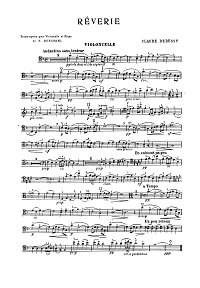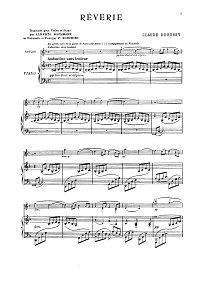Debussy - Reverie for cello and piano
Debussy - Reverie for cello and piano. You can download the sheet music Debussy - Reverie for cello and piano on this page. This colorful expressive creative - classical sample composition for cello by the recognized composer. This composition impresses listener by the well-listened shiny phrases of cello and piano and traditional interesting characteristics.
To view the first page of Debussy - Reverie for cello and piano click the music sheet image.
|
| PDF format sheet music |
|
|
|
Cello part: 1 pages. 140 K
|
Piano part: 5 pages. 616 K
|
 |
 |
|
|
| Download PDF (14.99
€) |
Download PDF (14.99
€) |
| During his visits to Bayreuth in 1888, Debussy was exposed to Wagnerian opera, which would have a lasting impact on his work. Debussy, like many young musicians of the time, responded positively to Richard Wagner's sensuousness, mastery of form, and striking harmonies. Wagner's extroverted emotionalism was not to be Debussy's way, but the German composer's influence is evident in La damoiselle élue and the 1889 piece Cinq poèmes de Charles Baudelaire. Other songs of the period, notably the settings of Verlaine – Ariettes oubliées, Trois mélodies, and Fêtes galantes – are all in a more capricious style.
Around this time, Debussy met Erik Satie, who proved a kindred spirit in his experimental approach to composition and to naming his pieces. Both musicians were bohemians during this period, enjoying the same cafe society and struggling to stay afloat financially. In 1889, at the Exposition Universelle in Paris, Debussy first heard Javanese gamelan music. He incorporated gamelan scales, melodies, rhythms, and ensemble textures into some of his compositions, most notably Pagodes from his piano collection Estampes. |
|